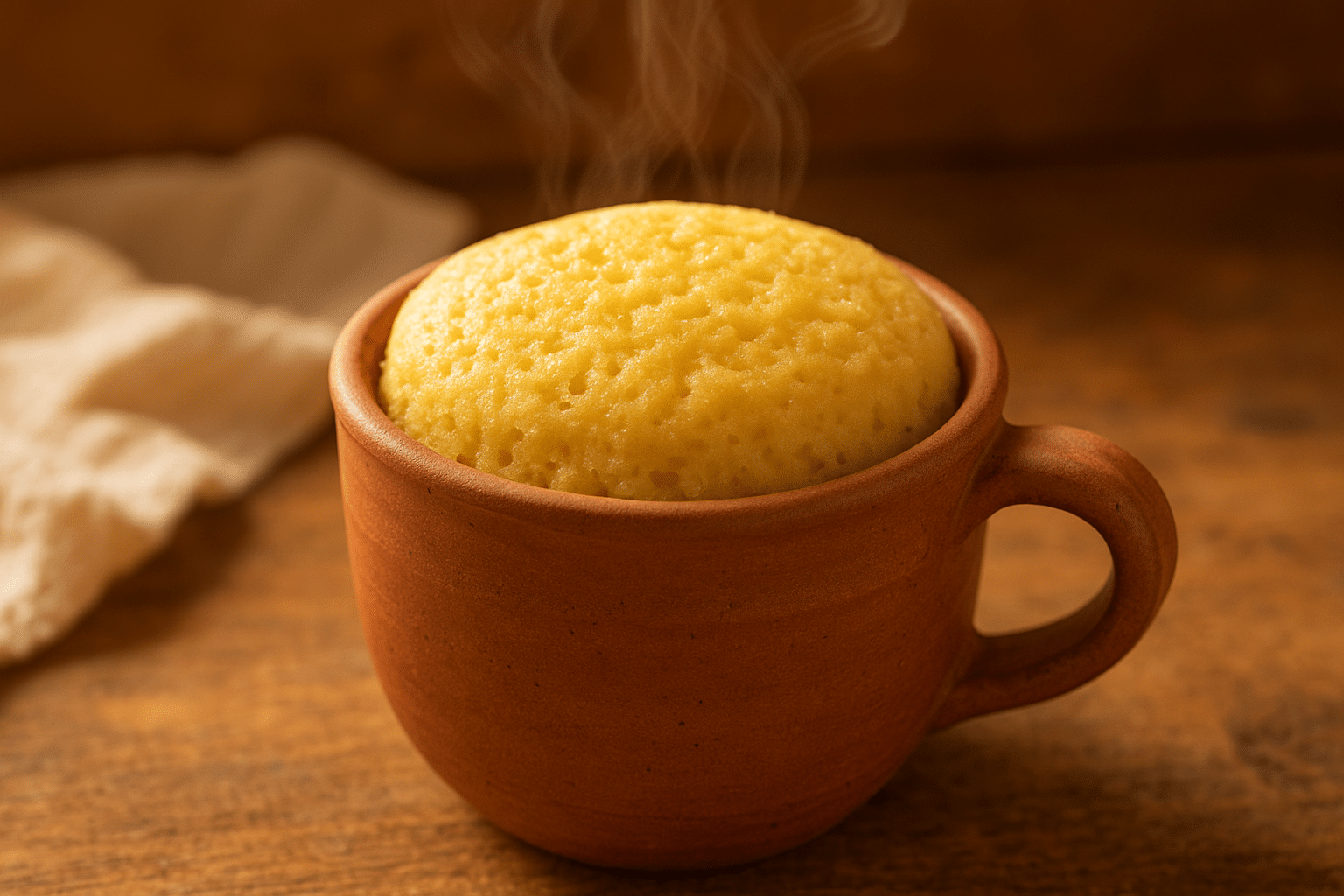Looking for an instant dessert fix? This 90-second mug cake transforms your microwave into a magical dessert machine! Moreover, this incredible recipe delivers warm, fluffy cake goodness faster than you can say “sweet tooth emergency.”
Furthermore, busy home cooks everywhere are discovering this game-changing technique that requires just one mug and basic pantry ingredients. Additionally, the entire process takes less time than preheating a traditional oven. In fact, this revolutionary approach to baking has become the ultimate solution for those midnight dessert cravings.
Meanwhile, families are bonding over this fun, foolproof recipe that even kids can master safely. Consequently, you’ll never look at dessert the same way again once you experience the convenience of a perfectly moist 90-second mug cake that’s ready to enjoy immediately after cooking.
Table of Contents
The Science Behind Perfect 90-Second Mug Cake Results
Understanding Microwave Baking Chemistry
The magic of a 90-second mug cake lies in understanding how microwaves interact with cake batter. First, microwaves heat food by exciting water molecules, creating steam that helps the cake rise rapidly. Subsequently, this process differs significantly from conventional oven baking, where heat gradually penetrates from outside to inside.
Therefore, microwave baking requires specific ingredient ratios to achieve the perfect texture. Additionally, the confined space of a mug creates ideal pressure conditions for quick rising. Furthermore, the key to success involves using ingredients that contain adequate moisture while maintaining proper binding agents.
Consequently, traditional cake recipes often fail in the microwave because they lack the precise balance needed for rapid cooking. Meanwhile, our perfected 90-second mug cake formula accounts for these scientific principles. For example, similar to our chocolate mug cake, the ratios create optimal steam distribution. Ultimately, understanding these principles ensures consistent results every single time you crave this quick dessert.
Temperature Control and Timing Mastery
Achieving the ideal 90-second mug cake requires precise temperature management throughout the cooking process. Initially, room temperature ingredients blend more easily and cook more evenly than cold ingredients straight from the refrigerator. Moreover, microwave power levels vary significantly between different models, affecting cooking times dramatically.
Therefore, most recipes work best on full power, but older microwaves might require slight adjustments. Additionally, the size and material of your mug influence heat distribution and cooking speed. Furthermore, ceramic mugs typically provide the most even heating compared to glass or plastic alternatives.
Consequently, monitoring your cake during the final 15 seconds prevents overcooking and ensures optimal moisture retention. Meanwhile, letting the cake rest for 30 seconds after cooking allows the heat to distribute evenly throughout. For instance, just like perfecting our vanilla mug cake, timing becomes intuitive with practice. Ultimately, mastering these temperature variables guarantees bakery-quality results from your microwave every time.
Essential Ingredients for Your 90-Second Mug Cake Success
Pantry Staples That Deliver Big Flavor
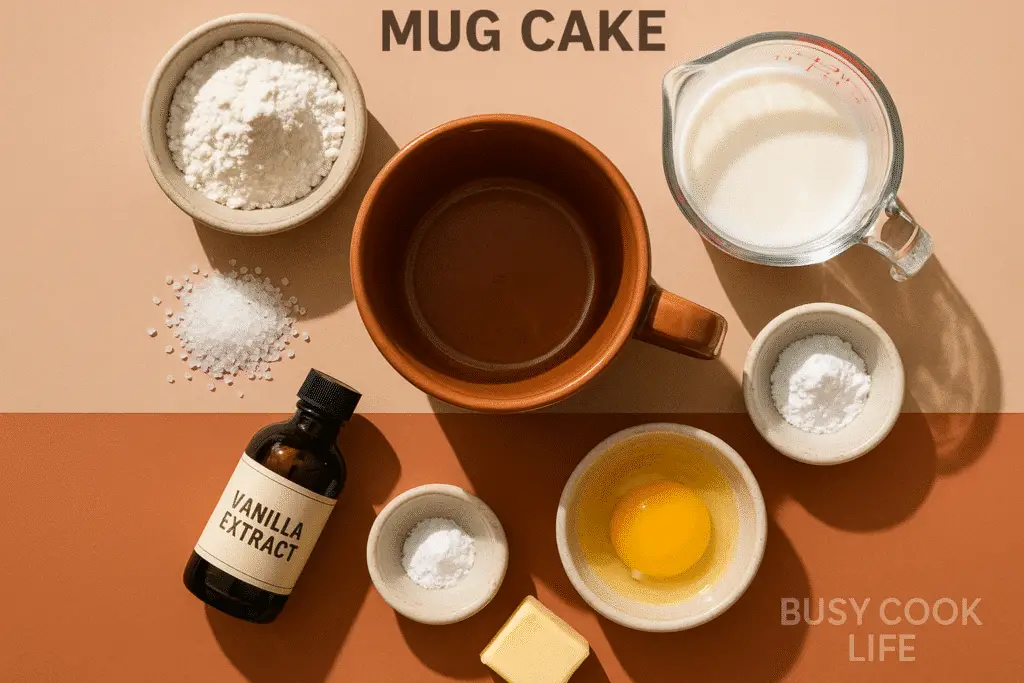
Creating an exceptional 90-second mug cake starts with selecting the right foundation ingredients from your pantry. First, all-purpose flour provides the essential structure, while baking powder acts as the crucial leavening agent for proper rise. Subsequently, granulated sugar not only adds sweetness but also contributes to the cake’s tender texture through moisture retention. Therefore, never substitute these core ingredients unless you understand their specific functions in the recipe.
Additionally, a pinch of salt enhances all flavors and balances the sweetness perfectly. Furthermore, vanilla extract elevates the overall taste profile significantly, making even simple cakes taste gourmet. Consequently, using fresh, high-quality ingredients directly impacts your final results. Meanwhile, keeping these staples properly stored ensures they’re always ready for impromptu baking sessions.
For example, similar to our birthday mug cake, quality ingredients make ordinary recipes extraordinary. Ultimately, investing in good basics pays dividends in every single 90-second mug cake you create in your busy kitchen.y impacts your final results. Meanwhile, keeping these staples properly stored ensures they’re always ready for impromptu baking sessions. For example, similar to our birthday mug cake, quality ingredients make ordinary recipes extraordinary. Ultimately, investing in good basics pays dividends in every single 90-second mug cake you create in your busy kitchen.
Moisture Magic: Oils, Milks, and Secret Additions
The liquid components in your 90-second mug cake determine whether you’ll achieve bakery-level moistness or disappointing dryness. Initially, vegetable oil creates the most consistently moist texture, though melted butter adds rich flavor complexity. Moreover, milk provides both moisture and helps activate the baking powder for optimal rising action. Therefore, whole milk typically produces the best results, but alternatives like almond or oat milk work beautifully too.
Additionally, room temperature liquids incorporate more smoothly than cold ingredients, preventing lumpy batter formation. Furthermore, some bakers swear by adding a tablespoon of sour cream or Greek yogurt for extra richness. Consequently, experimenting with different liquid combinations allows you to customize flavors while maintaining perfect texture.
Meanwhile, measuring liquids accurately ensures consistent results across multiple baking sessions. For instance, our lemon mug cake showcases how citrus juices can replace some milk for flavor variety. Ultimately, mastering moisture balance transforms your basic 90-second mug cake into a sophisticated dessert experience.
Step-by-Step 90-Second Mug Cake Preparation Techniques
Mixing Methods That Guarantee Perfect Texture
Proper mixing technique separates mediocre from magnificent 90-second mug cake results every single time. First, always combine dry ingredients thoroughly before adding any liquids to prevent pockets of flour or baking powder.
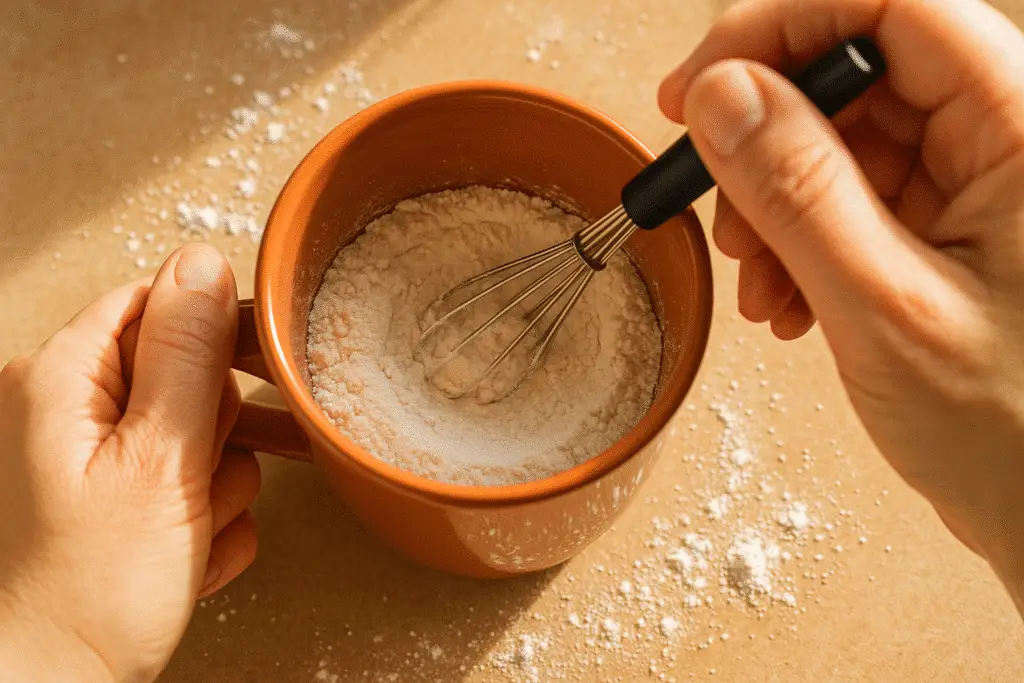
Subsequently, create a well in the center of your dry ingredients, then pour all wet ingredients into this depression. Therefore, this method ensures even distribution without overmixing, which can lead to tough, rubbery texture. Additionally, use a fork or small whisk to gently fold ingredients together, starting from the center and working outward. Furthermore, mix just until the batter comes together with no visible flour streaks remaining.
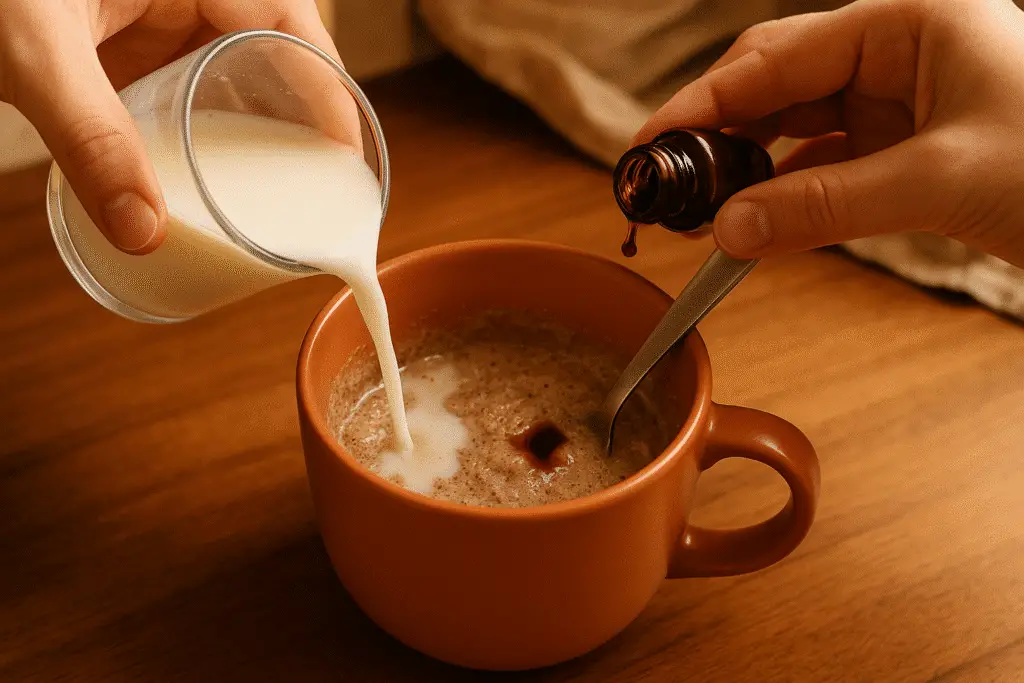
Consequently, overmixing develops gluten excessively, resulting in a dense, chewy cake instead of fluffy perfection. Meanwhile, a few small lumps are perfectly acceptable and will dissolve during cooking. For example, similar to our strawberry mug cake, gentle handling preserves optimal texture. Ultimately, mastering this simple technique ensures your 90-second mug cake emerges light, tender, and absolutely irresistible every time.
Microwave Positioning and Power Settings
Strategic microwave placement significantly impacts your 90-second mug cake cooking success and final texture quality. Initially, always position your mug in the center of the microwave turntable for optimal heat circulation and even cooking. Moreover, if your microwave lacks a turntable, manually rotate the mug halfway through cooking time.
Therefore, understanding your specific microwave’s power output helps adjust timing for perfect results consistently. Additionally, most standard home microwaves operate between 700-1200 watts, affecting cooking speed dramatically. Furthermore, starting with high power (100%) works best for most recipes, but lower power settings help prevent overcooking in powerful units.
Consequently, watching your cake during the final 15-20 seconds prevents the common mistake of overcooking. Meanwhile, the cake should rise significantly and appear set around the edges when properly cooked. For instance, techniques from our coffee cake mug cake apply universally across all microwave baking. Ultimately, adjusting these variables based on your equipment ensures consistently perfect 90-second mug cake results.
Troubleshooting Common 90-Second Mug Cake Problems
Preventing Rubbery Texture and Overflow Issues
Even experienced bakers occasionally encounter challenges when perfecting their 90-second mug cake technique and timing. First, rubbery texture typically results from overcooking or using too much flour in the initial mixture. Subsequently, reducing cooking time by 10-15 seconds often solves this common problem immediately.
Therefore, remember that residual heat continues cooking the cake even after the microwave stops. Additionally, overflow issues occur when using too much batter or insufficient mug size for the recipe quantity. Furthermore, filling your mug only halfway prevents messy overflow while ensuring adequate rising space.
Consequently, choosing a wide, tall mug over a narrow one provides better heat distribution and expansion room. Meanwhile, letting ingredients reach room temperature before mixing prevents uneven cooking and texture problems. For example, our chocolate chip mug cake demonstrates proper batter consistency and volume.
Ultimately, identifying and correcting these issues quickly transforms disappointing results into delectable 90-second mug cake successes.
Achieving Consistent Results Across Different Microwaves
Mastering 90-second mug cake consistency requires understanding how different microwave models affect cooking performance and timing. Initially, older microwaves often cook less evenly, requiring longer cooking times or multiple short intervals. Moreover, compact dorm-style microwaves typically have lower wattage, necessitating extended cooking periods for proper doneness.
Therefore, testing your specific microwave with small time increments helps establish optimal cooking duration. Additionally, commercial-grade microwaves cook much faster, often requiring reduced time to prevent overcooking disasters. Furthermore, keeping a cooking log helps track successful timing and power combinations for future reference.
Consequently, adjusting recipes based on your equipment ensures reliable results regardless of microwave variations. Meanwhile, visual cues like proper rising and set edges indicate doneness better than strict timing alone. For instance, principles from our peanut butter banana mug cake adapt across all microwave types.
Ultimately, developing equipment-specific techniques guarantees your 90-second mug cake success in any kitchen environment.
Frequently Asked Questions
How long should you microwave mug cake for?
For most standard microwaves (800-1000 watts), cook your 90-second mug cake for exactly 90 seconds on full power. However, start checking at 60 seconds, then add 15-second intervals if needed. The cake should rise significantly and appear set around the edges when done. Additionally, remember that cooking times vary based on microwave wattage and mug size, so adjust accordingly for your specific equipment.
What are the ingredients in the 3 ingredient mug cake?
The simplest 90-second mug cake requires just 3 tablespoons self-rising flour, 3 tablespoons milk, and 2 tablespoons sugar. Mix these ingredients directly in your mug, then microwave for 60-90 seconds. This basic recipe works perfectly for emergency dessert cravings, though adding vanilla extract or a pinch of salt enhances flavor significantly.
How to make mug cake not rubbery?
Prevent rubbery texture in your 90-second mug cake by avoiding overcooking and overmixing. Cook in shorter intervals (15-30 seconds) rather than one long session, and mix ingredients just until combined. Additionally, ensure your ingredients are room temperature and use adequate moisture from milk or oil. Finally, let the cake rest for 30 seconds after cooking to distribute heat evenly.
Why did my mug cake fail?
Common 90-second mug cake failures include wrong ingredient ratios, incorrect cooking time, or using the wrong mug size. Ensure you’re measuring accurately, using a microwave-safe mug that’s wide enough for rising, and adjusting cooking time for your microwave’s wattage. Additionally, check that your baking powder is fresh and that you’re not overmixing the batter, which creates tough texture.

Conclusion
Mastering the perfect 90-second mug cake opens up endless possibilities for quick, satisfying desserts that fit seamlessly into your busy lifestyle. Furthermore, this incredible technique proves that exceptional baking doesn’t require hours of preparation or professional equipment. Therefore, whether you’re dealing with late-night study sessions, unexpected guests, or simply craving something sweet, this recipe delivers consistently delicious results.
Additionally, the skills you develop creating basic 90-second mug cakes transfer beautifully to more complex variations and flavor combinations. Meanwhile, families everywhere are discovering the joy of baking together with this foolproof method that encourages creativity and experimentation.
Consequently, you’ll find yourself reaching for this reliable recipe whenever life demands quick comfort food solutions. For more amazing microwave recipes, explore our collection of vegan mug cakes and gluten-free options. Ultimately, this simple yet revolutionary approach to dessert-making proves that great things truly do come in small packages.
Connect with Emma & Get More Quick Recipes
Ready to transform your busy kitchen routine with more amazing microwave recipes? Join our growing community of time-saving home cooks who are discovering the joy of stress-free cooking! Moreover, you’ll find daily inspiration, cooking tips, and behind-the-scenes moments from Emma’s Asheville kitchen.
Follow Emma on Facebook where she shares her latest mug recipe discoveries, answers your cooking questions, and connects with fellow busy cooks from around the world. Additionally, you’ll get exclusive access to live cooking sessions and community recipe swaps that make cooking more fun than ever.
For visual inspiration and endless recipe ideas, check out our Busy Cook Life Pinterest boards featuring hundreds of tested microwave recipes, meal prep ideas, and kitchen hacks. Furthermore, you can easily save your favorite recipes and create your own collections of go-to meals for busy weeknights.
Together, we’re proving that incredible food doesn’t require hours in the kitchen – just creativity, community, and maybe a really good microwave!
Join Our Busy Cook Community
Love this 90-second mug cake recipe? There’s so much more where that came from! Emma shares new microwave cooking discoveries, kitchen shortcuts, and real-life cooking wins (and fails!) with thousands of busy home cooks who’ve found their tribe.
Connect with Emma and fellow busy cooks on Facebook for daily dose of cooking inspiration, quick recipe videos, and the support you need to make weeknight dinners less stressful. Plus, get first access to new recipes before they hit the blog!
Don’t forget to follow Busy Cook Life on Pinterest for hundreds of visual recipe ideas, meal planning templates, and those satisfying before-and-after kitchen organization tips that make cooking feel manageable again.
Because cooking should bring joy, not stress – and sometimes that joy comes in a mug, ready in 90 seconds flat!
Print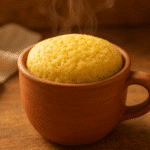
90-Second Mug Cake: Quick & Easy Microwave Recipe for Busy Cooks
- Prep Time: 2
- Cook Time: 90 seconds
- Total Time: 3
- Yield: 1 1x
- Category: Dessert
- Method: Microwave
- Cuisine: American
- Diet: Vegetarian
Description
Perfect 90-second mug cake recipe that delivers bakery-quality results in your microwave. This foolproof technique creates a fluffy, moist cake using simple pantry ingredients and takes less time than preheating a conventional oven.
Ingredients
4 tablespoons all-purpose flour 4 tablespoons granulated sugar 1/4 teaspoon baking powder Pinch of salt 3 tablespoons milk 2 tablespoons vegetable oil 1/4 teaspoon vanilla extract
Instructions
1. In a microwave-safe mug, whisk together flour, sugar, baking powder, and salt 2. Add milk, oil, and vanilla extract to the dry ingredients 3. Mix until just combined – don’t overmix 4. Microwave on high for 90 seconds 5. Let cool for 30 seconds before enjoying
Notes
Cooking time may vary based on microwave wattage. Start checking at 60 seconds and add time in 15-second intervals if needed. Use a wide mug to prevent overflow and ensure even cooking. Room temperature ingredients mix more easily and cook more evenly.
Nutrition
- Serving Size: 1 mug cake
- Calories: 320
- Sugar: 24g
- Sodium: 180mg
- Fat: 8g
- Saturated Fat: 1g
- Unsaturated Fat: 6g
- Trans Fat: 0g
- Carbohydrates: 58g
- Fiber: 1g
- Protein: 4g
- Cholesterol: 2mg

